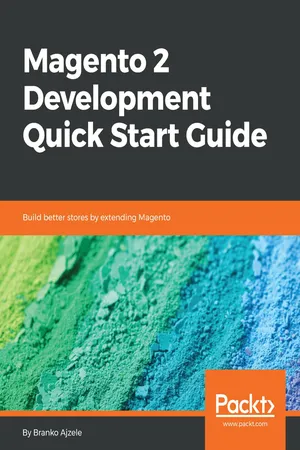
Magento 2 Development Quick Start Guide
Build better stores by extending Magento
Branko Ajzele
- 218 pages
- English
- ePUB (adapté aux mobiles)
- Disponible sur iOS et Android
Magento 2 Development Quick Start Guide
Build better stores by extending Magento
Branko Ajzele
À propos de ce livre
Create an interactive online store and customize it further using Magento
Key Features
- A straightforward guide to developing with Magento
- Examples of different types of extension
- Customize the Magento storefront and admin areas
Book Description
Magento is an open-source, enterprise-level e-commerce platform with unlimited scope for customization. This makes it a great choice not only for vendors but for developers as well.
This book guides you through Magento development, teaching you how to develop modules that extend or change its functionality, leading to more flexible and profitable Magento stores. You start with a structural overview of the key Magento development components.
You will learn where things such as plugins, events, models, controllers, layouts, and UI components ft into the development landscape. You will go through examples of using these components to extend Magento. As you progress, you will be building a diverse series of small but practical Magento modules.
By the end of this book, you will not only have a solid foundation in the Magento development architecture; but you will also have practical experience in developing modules to customize and extend Magento stores.
What you will learn
- Develop a simple shipping module
- Build admin interfaces with the built-in form and listing UI components
- Implement JavaScript components for improved customer experience
- Accommodate vendor needs by adding new catalog-related features
- Develop your way to a better checkout
- Improve customer interaction with new customer-related extensions
- Create new web APIs to make your modules more extensible
Who this book is for
This book is for competent PHP developers, with only basic knowledge of the Magento platform required.
Foire aux questions
Informations
Understanding the Magento Architecture
- Installing Magento
- Modes
- Areas
- Request flow processing
- Modules
- Cache
- Dependency injection
- Plugins
- Events and observers
- Console commands
- Cron jobs
- We are working on the magelicious.loc project
- We are referring to our project root directory as <PROJECT_DIR>
- We are referring to the <PROJECT_DIR>/app/code/Magelicious directory as <MAGELICIOUS_DIR>
- We are referring to Magento's vendor/magento directory as <MAGENTO_DIR>
- We have a running LAMP/MAMP/WAMP stack (Apache, MySQL, PHP) that is compliant with Magento's requirements
- We have a Composer package manager installed
- We have access to crontab (Linux, MacOS) or Task Scheduler (Windows)
Technical requirements
https://github.com/PacktPublishing/Magento-2-Quick-Start-Guide.
Installing Magento
- Magento Open Source: The free version, targeting small businesses
- Magento Commerce: The commercial version, targeting small, medium, or enterprise businesses
- Source file archive (.zip, .tar.gz, .tar.bz2), available at https://magento.com
- Git repository, available at https://github.com/magento/magento2
- Composer repository, available at https://repo.magento.com
composer create-project --repository-url=https://repo.magento.com/ magento/project-community-edition .
- Via the Web Setup Wizard: The graphical, browser-based process
- Via the command line: The command-line-based process
php bin/magento setup:install \
--db-host="/Applications/MAMP/tmp/mysql/mysql.sock" \
--db-name=magelicious \
--db-user=root
--db-password=root \
--admin-firstname=John \
--admin-lastname=Doe \
[email protected] \
--admin-user=john \
--admin-password=jrdJ%0i9a69n
Starting Magento installation:
File permissions check...
[Progress: 1 / 513]
Required extensions check...
[Progress: 2 / 513]
Enabling Maintenance Mode...
[Progress: 3 / 513]
Installing deployment configuration...
[Progress: 4 / 513]
Installing database schema:
Schema creation/updates:
Module 'Magento_Store':
[Progress: 5 / 513]
[Progress: 508 / 513]
Installing admin user...
[Progress: 509 / 513]
Caches clearing:
Cache cleared successfully
[Progress: 510 / 513]
Disabling Maintenance Mode:
[Progress: 511 / 513]
Post installation file permissions check...
For security, remove write permissions from these directories: '/Users/branko/Projects/magelicious/app/etc'
[Progress: 512 / 513]
Write installation date...
[Progress: 513 / 513]
[SUCCESS]: Magento installation complete.
[SUCCESS]: Magento Admin URI: /admin_mxq00c
Nothing to import.
php bin/magento deploy:mode:set developer Modes
Table des matières
- Title Page
- Copyright and Credits
- Packt Upsell
- Contributors
- Preface
- Understanding the Magento Architecture
- Working with Entities
- Understanding Web APIs
- Building and Distributing Extensions
- Developing for Admin
- Developing for Storefront
- Customizing Catalog Behavior
- Customizing Checkout Experiences
- Customizing Customer Interactions
- Other Books You May Enjoy